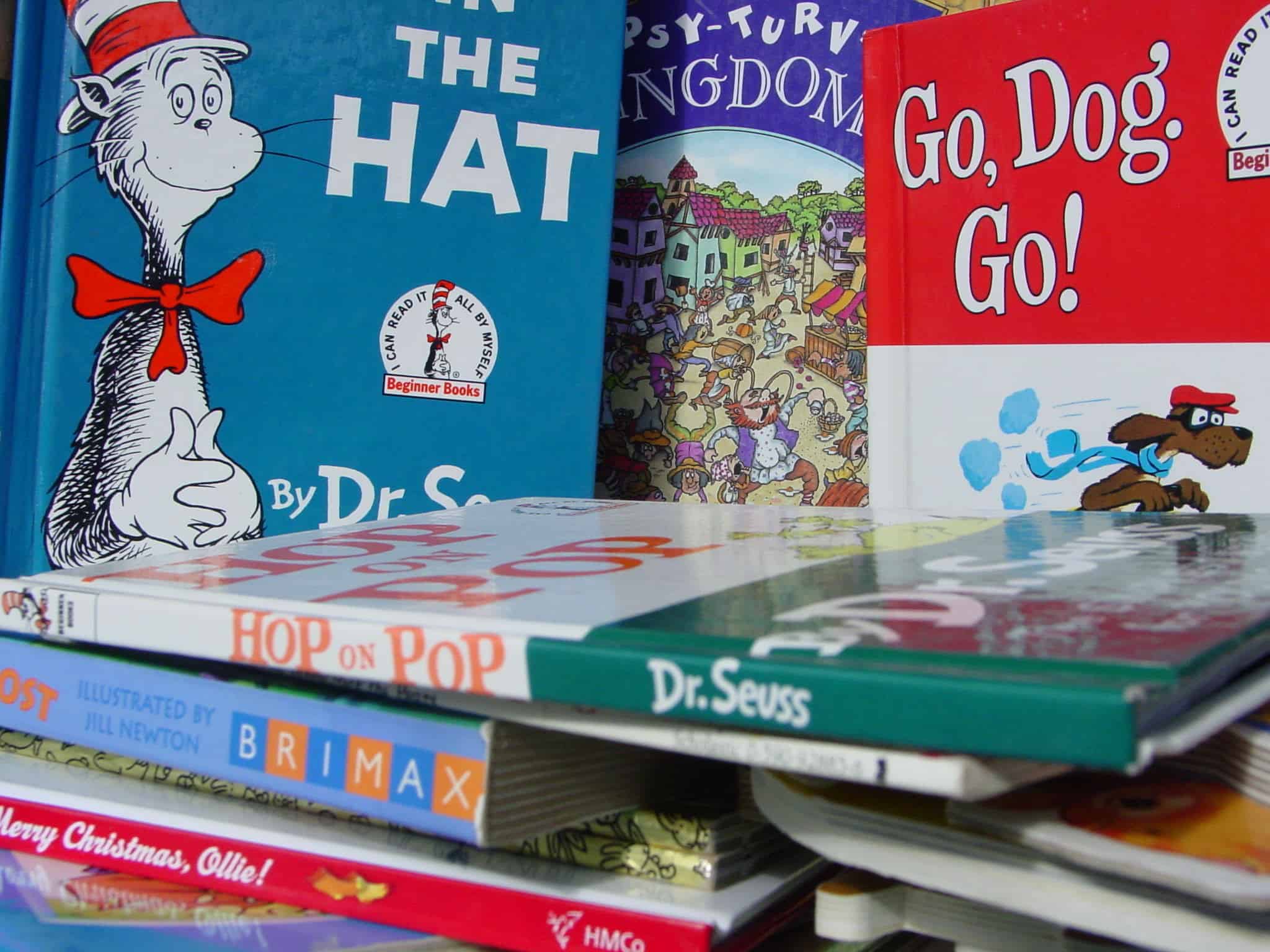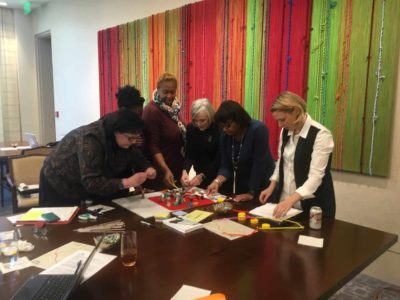It is loud in a room filled with 14 toddlers and preschoolers who have grown tired of coloring and their juice boxes. Their sounds echo through the building made from cement blocks.
Backpacks adorned with Elsa and Spiderman sit on the floor. The kids, seated next to their parents or grandparents, dangle their scrawny legs from red-cushioned chairs. There are cupcakes, and several kids smash their faces into the frosting while their mothers are otherwise occupied.
Once a week, this is a Sunday School classroom, but today, a hot Tuesday at the end of March, it is home to a Read Charlotte active reading workshop. St. Andrew’s United Methodist Church, inside Read Charlotte’s transformation zone, is one of seven sites holding these workshops. The four-session trainings are part of the group’s 100 Day Challenge, an effort to accelerate the early stages of its quest to double Mecklenburg County’s third grade reading proficiency by 2025.
Posters taped to the gray walls highlight the ABCs of active reading: Asking Questions, Building Vocabulary, Connecting to Their World. Most of the children attend the church preschool, and this early afternoon session was scheduled to coincide with parent pickup. Some of the adults are stay-at-home moms and dads; others have employee ID badges dangling from their belts and are clearly on a lunch break from work. Many of the families are immigrants from southwest Asia, and English is not their family’s primary at-home language.
Samantha Cleaver, Read Charlotte’s research assistant, is in the center of a horseshoe-shaped arrangement of tables. Joining her is Colleen Davis, a former Charlotte-Mecklenburg Schools teacher who now works for Freedom School Partners, a nonprofit that serves at-risk kids with summer learning and literacy programming. The group is one of several that partner with Read Charlotte.
The facilitators ask the parents to go around the room, introduce themselves, and explain why they signed up for the workshop.
“I want to see how quickly she can read,” says one parent in a thick accent, as she points to her two-year-old daughter.
Another mom speaks up about her little girl. “She loves to read and we love to read together. I feel like she’s ready to learn to read more; I’m just not sure how to take her there.”
By the time all the parents finish their introductions the children are boisterous. One boy is literally bouncing off the walls—running into them and pushing himself backward. Cleaver leads a rendition of “Open, Shut Them” to get everyone to settle down.
The facilitators ask the children to join them in a circle on the tile floor. Davis is going to read a book, Flower Garden, to the kids using active reading strategies while Cleaver explains the techniques to the parents.
Davis starts by pointing to the title, author, and illustrator to the group. She shows off the front and back covers, orienting the children to the idea that they will read right-to-left and top-to-bottom. This is called “print knowledge” and can get even the youngest readers comfortable with how a book works.
Cleaver explains that before reading a book to their children, the grown-ups should go on “picture walks,” simply flipping through the book and having a discussion about the pictures. The idea is that children are more comfortable with the book before they read a word—making them more likely to pick up vocabulary and context along the way.
“Why do you think she’s sitting down?” Davis asks, pointing to the story’s main character in one illustration.
“Because!” shouts a four-year-old with bright orange hair who appears to be one of the more advanced readers in the group.
After a few more minutes, Cleaver and Davis ask the families to read on their own. The exercise concludes with varying degrees of success—some engaged readers and others who barely acknowledge the book in front of them—and one parent seems doubtful his child will be able to master the active reading skills. Cleaver reassures him by sharing that even she was not aware of active reading strategies when her daughter was ready to begin reading, and that their family changed their habits after learning more about the benefits of active reading.
It’s OK to be nervous, to be distracted, she says.
“It’s really hard as a parent to be focused on what (children) are focused on and not the 18 things you have to do later,” Cleaver says. Heads nod in unison and knowing smiles spread across the parents’ faces.
***
The active reading workshops illustrate both the challenges and potential of Read Charlotte’s ambitious goal.
The sessions are limited to 20 families—just imagine more than 20 four-year-olds in a room for a one-hour meeting—in a county of a million people. Parents have to opt in; some of the most at-risk children will not benefit from this particular type of programming because their parents are working, do not have reliable transportation, or do not hear about the training. The workshops require commitment and necessitate families invest time beyond the classroom to realize gains in reading proficiency.
But the active reading skills are not difficult for parents to grasp. The session included affluent and working class families, advanced and struggling readers. The parents were apprehensive (it is hard to admit you do not know what you are doing while trying to raise a kid) but eager to pass along their love of books to their children. And it was easy to see how this simple curriculum and its straightforward strategies could scale across the county.
“We’re a temporary organization,” said Munro Richardson, Read Charlotte’s executive director, when we talked in March. “We go away in 10 years. I don’t know what I’ll be doing in 10 years, but it won’t be this. So we have to work in a way that we are building capacity in the entire county and in organizations that were here before us and will be here after us.”
The location of Read Charlotte’s transformation zone is striking. The place where the organization chose to focus its 100 Day Challenge is less than three miles from the city’s most exclusive golf club, a place where homes sell for millions of dollars and power players close big deals. Is it possible that there was some symbolism in that decision?
Richardson said no. The decision related to the zone’s characteristics—access to public transportation, its economic and racial demographics, things like that—and was not intended to be a subconscious message to Charlotte’s elite and upper-middle class.
But, he quickly added, “If Read Charlotte is ‘they and them’ and not ‘us and our,’ we’re going to fail.”
Perhaps it is appropriate that Richardson and his staff talk about failure so much. No other city in America has accomplished what Read Charlotte is attempting to do. It is difficult to understate the scope of its mission—to double the third grade reading rate, in a place of Charlotte’s size—or its reverberating effects on education across the nation if it succeeds.
“Charlotte, nationally, has been one of the shining examples for public education for years,” Richardson said. “So doing this in Charlotte will mean something. We’re big enough and we’re consequential enough that it will matter nationally.”
***
The children are in a different Sunday School classroom—this one is smaller, with cinder block walls painted mint green—although the kids are just as boisterous. Most of the families who attended the first session, a month ago, are here again. A few are out sick with late spring colds.
They sing “Open, Shut Them” and “Zoom, Zoom, Zoom” just like they did at the earlier session. Facilitators, including Colleen Davis, read parts of a story as the children sit on the floor. Something feels different, though, despite the kids’ usual energy.
The facilitators ask how the read-at-home exercises went during the past week. Are you reading differently, they ask, than you did before?
“Oh, yes,” one grandmother replies. “Definitely.”
A young mom nods her head vigorously.
The sessions seem to be working.
This final installment of the active reading workshop is intended to focus on open-ended questions. While the kids sip juice and eat pizza, the leaders explain the concept. Open-ended questions do not have a right or wrong answer. (This is a difference from story questions—specific questions about plot or characters that have a finite answer.) While reading, grown-ups should ask children to make inferences and predictions, to offer opinions and perspectives. They should ask, “What do you think will happen next?” or “Was that a good idea?”
The idea is to get kids to think on their own, to apply some of the other knowledge they have built—vocabulary skills, for example—to make inferences without relying on their parents.
As with the previous sessions, the facilitators read a few pages of a book to the kids. Today, it is I Stink, a funny book about a smelly garbage truck. One facilitator demonstrates the active reading skills while the other explains them to the adults. Then, after a moment, they ask the families to practice the skills one-on-one.
A few minutes later, one of the facilitators asks one of the children—the boy who could not sit still the first week—if he wants to leave his mother’s lap and sing a song with the other kids.
The little boy, without a word, shakes his head, picks up the paperback book in front of him, and waves it in the air. He wants to read.



